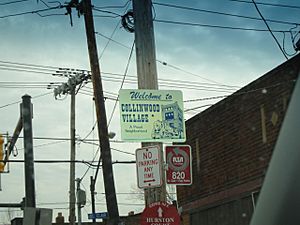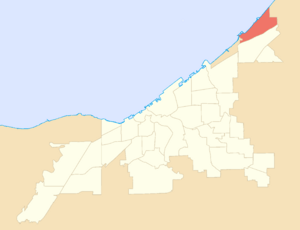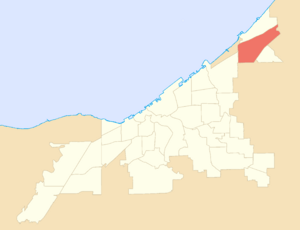Collinwood facts for kids
Quick facts for kids
Collinwood
|
|
|---|---|
|
Neighborhood of Cleveland
|
|
 |
|
 |
|
 |
|
| Country | United States |
| State | Ohio |
| County | Cuyahoga |
| City | Cleveland |
| Population
(2020)
|
|
| • Total | 15,780 (North Shore Collinwood) 10,785 (Collinwood–Nottingham) |
| Demographics (North Shore Collinwood) | |
| • White | 29.9% |
| • Black | 63% |
| • Hispanic (of any race) | 1.1% |
| • Asian and Pacific Islander | 0.1% |
| • Mixed and Other | 6.9% |
| Demographics (Collinwood–Nottingham) | |
| • White | 10.9% |
| • Black | 84.2% |
| • Hispanic (of any race) | 1.4% |
| • Asian and Pacific Islander | 0.4% |
| • Mixed and Other | 4.6% |
| Time zone | UTC-5 (EST) |
| • Summer (DST) | UTC-4 (EDT) |
| ZIP Codes |
44110, 44119
|
| Area code(s) | 216 |
| Median income | $27,935 (North Shore Collinwood) $26,404 (Collinwood–Nottingham) |
| Source: 2020 U.S. Census, City Planning Commission of Cleveland. | |
Collinwood is a historic area in the northeast part of Cleveland, Ohio. It used to be a small village. In 1910, it became part of the city of Cleveland. Collinwood grew because of the large train yards nearby. These train tracks still divide the area into two main neighborhoods: North Shore Collinwood and Collinwood–Nottingham. In 2008, Travel + Leisure magazine even called Collinwood one of America's Best Secret Neighborhoods!
Contents
History of Collinwood
Collinwood has a long and interesting history. It has seen big changes over the years.
The Collinwood School Fire
Before Collinwood joined Cleveland, a very sad event happened there. On March 4, 1908, the Collinwood School Fire broke out at Lakeview Elementary School. This was one of the worst school fires in American history. A total of 172 children, two young teachers, and one rescuer died. Most victims were trapped in the stairwells. They were crushed or suffocated while trying to escape.
Many people thought the doors opened inward, trapping the students. But a report later showed the doors actually opened outward. Those who could not be identified were buried together in a mass grave. This tragic fire led to new rules for public buildings. Across the country, cities started inspecting schools. They also made building codes stricter to prevent similar disasters.
Growth and Industry
In 1912, parts of the village of Nottingham also became part of Collinwood. For most of the 1900s, Collinwood was a busy place. It thrived thanks to many large factories. Besides the train yards, big companies like General Motors and General Electric had plants here. These factories employed thousands of workers.
Before World War II, many people moved to Collinwood for jobs. These included European immigrants and families from the Southern United States. By the 1960s, many African American families moved in. Today, they make up most of the population in both North and South Collinwood.
Changes in the 21st Century
In recent years, Collinwood has become a popular spot for artists. They look for affordable places to live and work in the city. Even though the housing crisis affected the neighborhood, it also created chances for artists to buy properties cheaply. A group called Arts Collinwood has worked hard to help make the Waterloo Road area lively again. This area is a business district on the north side of the neighborhood.
North Shore Collinwood
North Shore Collinwood, often called North Collinwood, was mainly a residential area. It stretches from about E. 133rd Street to E. 185th Street. It goes from Lake Erie in the north down to the Collinwood Railroad Yards in the south.
North Collinwood is home to several parks. These include Wildwood Park and Marina, East Shore Park, and Beachland Park. It was also the location of the historic Euclid Beach Park. The Villa Angela-St. Joseph High School is located here.
Collinwood–Nottingham
Collinwood–Nottingham, known as South Collinwood, used to be the more industrial part of Collinwood. It is roughly bordered by E. 134th Street on the west and Euclid Creek on the east. The Collinwood Railroad Yards are to its north.
The "Five Points" area is the main business district. This is where Ivanhoe Road, St. Clair Avenue, and E. 152nd Street meet. Collinwood High School is also located here. Its sports teams are called the Railroaders, which fits the area's history!
Diverse Communities
Even though South Collinwood is mostly African American today, it has a rich history of different immigrant groups. It was once home to many Eastern Europeans, especially a large Slovenian community. This community was centered around St. Mary of the Assumption Church and the Slovenian Home on Holmes Avenue. George Voinovich, who became Cleveland's mayor, Ohio's governor, and a U.S. Senator, grew up in this Slovenian neighborhood. Frankie Yankovic, known as America's Polka King, was also from South Collinwood. He played polka music in many local places.
Many Italians also settled heavily in the area. They often moved from Cleveland's "Big Italy" district. This "Italian Village" became famous for its Feast of St. Anthony in June and the Feast of the Assumption in August. These events were held at Holy Redeemer Catholic Church.
American immigrants, especially from the Southern United States, started arriving in the 1940s. They came to work in the factories. Many settled along the western edge of the neighborhood. Bars in that area often featured live country music and Southern food.
South Collinwood was also once the main office for the Jordan Motor Car Company. This company made cars from 1916 to 1931. Their plant was located where the Collinwood athletic complex is today.
Notable Residents
Many interesting people have lived in Collinwood. Here are a few:
- Tony Adamle (1924–2000) – a professional football player for the Cleveland Browns.
- Eppie Barney (1944– ) – a professional football player for the Cleveland Browns.
- James Cotton (1976– ) - a professional football player.
- Wes Craven (1939-2015) – a famous film director and writer.
- Jerry Dybzinski (1955– ) – a Major League Baseball player.
- Alexis Floyd (1993– ) – a stage and television actress.
- John Claude Gummoe (1938– ) – a singer-songwriter and lead singer of The Cascades. He wrote "Rhythm of the Rain".
- Jeff Johnson – a Cleveland City Council member and former Ohio state senator.
- Dick Latessa (1929–2016) – a stage, film, and television actor.
- Joey Maxim (1922–2001) – a professional boxer and World Light Heavyweight Champion.
- Andre Norton (1912–2005) – a well-known author.
- Sam Palumbo (1932– ) – a professional football player.
- Michael D. Polensek (1949– ) – a Cleveland City Council member.
- Monica Potter (1971– ) – a film and television actress.
- Cecil Shorts III (1987– ) – an NFL player.
- Stephanie Tubbs Jones (1949–2008) – a US Congresswoman.
- The Vadnals (1937–1995) – a Cleveland-style polka band.
- George Voinovich (1936–2016) – the 54th Mayor of Cleveland, 65th governor of Ohio, and a two-term U.S. Senator.
- Ray Zeh (1914–2003) – a football player for Western Reserve. He led college football in scoring in 1935.

